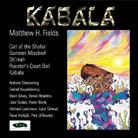April 2000
People who frequent the various classical music newsgroups on the Internet will be familiar with the ubiquitous "Dr. Matt" (Matthew Fields’ screen name). On this album he backs up his often-opinionated posts with an aptitude for writing for small ensembles and solo instruments. Fields uses the tone-row method to create his compositions, but unlike serial composers of a generation ago, he is not afraid to form tonal figures with his original notes. Constructing music with tone rows while forming consonances with them leads to some uneasy shifts between dissonant and tonal passages. The work entitled Kabala -- named after a Medieval Jewish text -- is superbly performed and recorded. It's scored for piano, viola and clarinet, and the composer describes childhood emotions with candid passion using frequent juxtapositions of calm and frenetic passages. Despite the constant changes in texture, Fields never varies his harmonic vocabulary, which makes this the most consistent composition offered on the CD. Two other pieces inspired by Jewish liturgical music are not as successful. The composition for carillon entitled Sh’mah is based on the familiar melody "Sh’mah Yisrael." Since Judaism isn’t known for large, cathedral-like sanctuaries that would ordinarily house such an instrument, this simple melody played on such an array of bells creates an eerie effect. Yet composing for the carillon was not a haphazard decision. In his notes, Fields recalls the many carillon concerts at the University of Michigan. His resulting familiarity with the instrument led to the present composition. Although the structure and harmonic plan are obscured by the sustaining quality and timbre of the bells, this effect, writes Fields, "is not entirely accidental." Call of the Shofar is a work for trombone quartet that repeatedly changes texture like most of the other pieces presented here. The contrapuntal passages are written in a contrived semi-baroque style, and Fields seems uncomfortable writing homophonically. The piece is sloppily played by a Morehead State University ensemble and is not of the same caliber as the other pieces on this CD. Two compositions for solo instruments complete this disc. Harpsichordist Libor Dudás performs Summer Mischief with a great deal of style and aplomb. He handles the complex music so delicately that the shifts from contrapuntal to chordal passages flow effortlessly. Whether the effect of a resonant concert hall was added to the recording or if the venue was actually a large hall, the resulting sound lends a false ring to an otherwise good recording. Flutist Michael Laderman flawlessly negotiates the lengthy programmatic work Rooster’s Court Ball in a studio recording that is a pleasure to listen to. Fields displays a sense of humor in this composition, which is a welcome respite from the other emotionally charged pieces. Diverse recording venues and varying degrees of expertise in both performance and engineering make the Kabala CD an unbalanced recording. The piece for trombone quartet should not be offered on a commercial CD. Yet this album illustrates the devotion that a little-known composer must possess in order to bring his music to the public. In time, Mr. Fields might have the luxury of selecting from a variety of his works to present on a future album, supported by the technical expertise of an established label. GO BACK TO: |
 Matthew Fields - Kabala
Matthew Fields - Kabala![[Reviewed on CD]](../format/regcd.gif) Matthew
Fields’ recent Kabala CD gives admirers of contemporary classical music a
glimpse of a composer who works outside the mainstream and away from artistic hubs. Fields
produced and, in some cases, recorded the album himself, and his lack of experience in
these technical areas raises a difficult question: When is a CD ready for public
consumption? In this recording there are serious problems with the performance of one of
the pieces and questionable production choices on others. However, the album is not
without merit, and it is a serious statement by an earnest young artist.
Matthew
Fields’ recent Kabala CD gives admirers of contemporary classical music a
glimpse of a composer who works outside the mainstream and away from artistic hubs. Fields
produced and, in some cases, recorded the album himself, and his lack of experience in
these technical areas raises a difficult question: When is a CD ready for public
consumption? In this recording there are serious problems with the performance of one of
the pieces and questionable production choices on others. However, the album is not
without merit, and it is a serious statement by an earnest young artist.